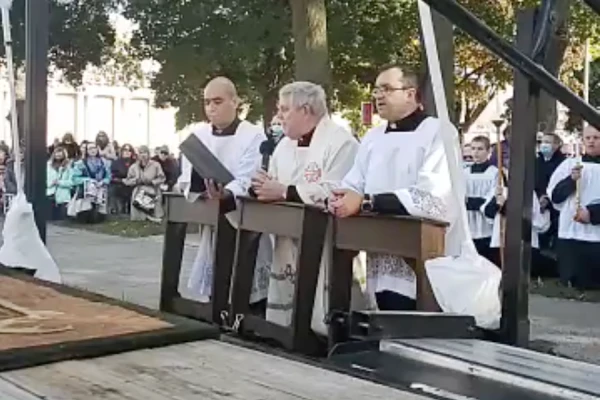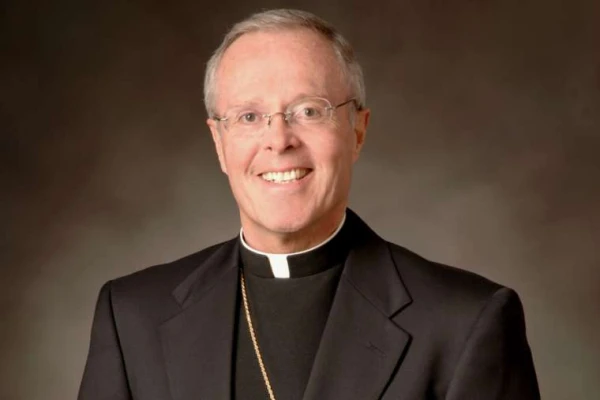
Denver Newsroom, May 28, 2020 / 03:00 am (CNA).- All of Florida’s death row inmates live in the Diocese of St. Augustine. Many are Catholic. At least twice a year St. Augustine’s Bishop Felipe Estevez goes to visit death row inmates himself.
So when Estevez issued a pastoral letter this week chronicling the efforts of Catholics in Florida to end the death penalty, and laying out the Catholic case for its abolition, the issue was personal.
“Justice needs to be restorative, not out of vengeance,” Estevez told CNA May 27.
“We don’t want anyone in society to be in danger because of these criminals, but we don’t think that death is the answer. Killing them because they have killed would perpetuate the cycle of violence.”
Jesus, on the cross, stopped a cycle of violence, Estevez said, by forgiving his killers.
“We need to put a stop to the death penalty because, as John Paul II said, it is not necessary. We can put all our energy into having the best prison system so that these prisoners who are a danger to society will not do any harm to anybody.”
Estevez notes that no death row inmate in Florida has been granted clemency since 1983, and with 350 death row inmates, Florida has the largest active death row in the United States— indeed, in all the Americas.
California has more prisoners on death row, but the state’s death penalty is currently under moratorium.
At least 50 of the men on Florida’s death row are Catholic, Estevez told CNA.
Estevez said he wanted his letter to reflect the commitment and care of those involved in prison ministry to death row inmates. There are over 27 prisons in the St. Augustine diocese.
Prison ministers provide much-needed accompaniment to prisoners, he said, helping provide an opportunity for them to repent.
“As they are being treated with love…something happens within their hearts, that tenderness transforms their hearts. And it is a very slow process…they have been damaged by violence. And so gentleness, mercy, accompaniment, and friendship and dialogue, all of that creates a culture of peace,” he said.
“I think the reason why [the volunteers] persevere, and they are so committed, it is because they witness that transformation.”
He said he sees the decline over the past few decades in executions throughout the country as a sign that more and more people are embracing a culture of life.
Society often tends to meet acts of violence with more violence, Estevez said.
“We need to heal that reaction— violence needs to be tempered by mercy,” he said.
“We don’t need to be engaged in vengeance, we don’t need to be involved in killing. We need to be involved in restoration.”
The bishop pointed to instances where the families of murder victims have asked that their loved one’s killer not receive the death penalty.
“They who have been hurt the most are thinking and acting as Christians,” he observed.
Estevez’s letter lays out a recent history of the development of the Church’s teaching on the death penalty.
The letter quotes a speech that Pope St. John Paul II delivered in St. Louis in 1999, in which he called for an end to the death penalty, calling it “cruel and unnecessary.”
“The new evangelization calls for followers of Christ who are unconditionally pro-life: who will proclaim, celebrate and serve the Gospel of life in every situation,” John Paul II said.
“A sign of hope is the increasing recognition that the dignity of human life must never be taken away, even in the case of someone who has done great evil. Modern society has the means of protecting itself, without definitively denying criminals the chance to reform.”
\John Paul II’s 1995 encyclical Evangelium vitae notes that cases in which executing an offender is an “absolute necessity” are, thanks to improvements in the penal system, “very rare if not practically nonexistent,” and reaffirms the Catechism’s teaching that “bloodless means” are “more in conformity to the dignity of the human person.”
“Not even a murderer loses his personal dignity, and God himself pledges to guarantee this,” John Paul II wrote.
Pope Benedict XVI, too, continued to support the limitation and eradication of the death penalty during his pontificate, Estevez writes.
During August 2018, Pope Francis ordered a revision to the Catechism of the Catholic Church, updating it to describe the death penalty as “inadmissible” and an “attack on the inviolability and dignity of the person.”
Many Christians attempt to use Bible passages to justify the death penalty, but the death penalty as it exists in the United States, Estevez says, is particlarly contrary to a biblical view.
Dale Recinella, a Catholic death row chaplain in Florida and frequent collaborator with Bishop Estevez, used his skills as a lawyer to analyze how the death penalty, as applied in the US, compares to the requirements found in the Bible.
Recinella identified 44 requirements of the biblical death penalty when it was the law of the land in Israel. He found that the death penalty, in Florida and the US, scored zero out of 44 on the requirements of the biblical death penalty.
Estevez noted that the bishops of Florida have collectively expressed their opposition to the death penalty ever since the US Supreme Court ruling in 1972 that forced states to resses their statutes for capital offenses.
At the time, the Florida bishops acknowledged that those who could pay for lawyers and appeals would likely avoid the death penalty, while “circumstantial evidence and discrimination in jury selection would inordinately affect the poor and minorities.”
John Sullivan, a Catholic inmate executed in 1983, received spiritual support and advocacy from Bishop John J. Snyder, Estevez’s predecessor.
The bishops continued to speak out as Florida scheduled more executions, issuing public pleas for stays of execution and mercy in every case of a scheduled execution in the 2000s.
The pastor of St. Mary, Mother of Mercy Parish, in Macclenny, Florida has had the primary responsibility for the church’s ministry at death row since 1976, Estevez said, with volunteers making themselves available for a quiet prayer vigil with the inmate’s family during the execution, and the pastor available to celebrate Mass at the church immediately following the execution.
The prison ministers at St. Mary’s also make the rounds in the death row prisons to bring the sacraments to those who are Catholic.
In June 1999, St. Marys’ parish council unanimously voted to formally pass a moratorium resolution on the death penalty, making it one of only two parishes in the country to have done so.
Defending human life at all costs requires courage and can be dangerous, Estevez said, recalling the story of Father Rene Robert, a St. Augustine priest who in 2016 attempted to help a troubled young man who subsequently kidnapped and murdered him.
Father Robert had, in 1995, signed a “Declaration of Life” asking that his killer not be put to death should he ever die by homicide. As a result, his killer was sentenced to life in prison.
Prisons are human institutions, and thus are fallible, Estevez writes, and thus “there is a great need for vigilance toward the effectiveness of prison security, even in well-developed societies, so these systems do not deteriorate or become corrupt and endanger their citizens.”
But:
“Our system of incarceration needs to change from inhumane punishment to hopeful rehabilitation. Everyone must be concerned that not a single innocent human is condemned to deadly execution,” he wrote.
“Our pastoral experience in caring for inmates has revealed that many of them have experienced a conversion of heart, and society can benefit from a reunion with their families and re-entry to society,” he concluded.
Estevez invoked the intercession of Our Lady of La Leche— who is honored at the newly-elevated national shrine at Mission Nombre de Dios in St. Augustine— consecrating to her the effort to end capital punishment in Florida.
 […]
[…]






Leave a Reply